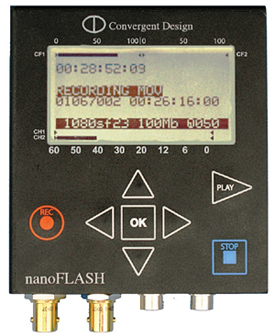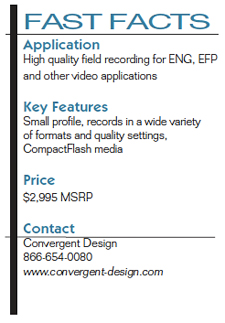Convergent Design’s nanoFlash Recorder

Convergent Design’s nanoFlash recorder/player
There are times when I love watching the competitive aspects of the marketplace of our industry at work, and there are times when I find its machinations absolutely appalling.
Examples of the latter are the VHS/Betamax and Blu-ray/HD-DVD smack downs, and a great example of the former is Convergent Design’s nanoFlash, along with the entire emerging line of high quality digital video and audio field recorders.
The proliferation of HD shooting and post-production at all budget and quality levels has brought with it a demand for field recorders to provide longer shooting times, higher quality recording capabilities than those available in camcorders, and greater flexibility and efficiency in post workflows. These range widely in price and feature sets, and feature a wide variety of recording media and methods, I/O options, size, portability and configuration.
Competition and innovation from the creators of these devices have made them all more dependable, more affordable and better functioning.
Building in part on its experience in making digital video conversion hardware, Convergent Design created the Flash XDR. This is a cigar-box sized digital recorder with SD and HD-SDI inputs and outputs (and analog and digital audio I/O) that records MPEG-2 video to a block of four CompactFlash cards. Based on the success of that product, the company has launched a new sibling, the nanoFlash, which is a smaller and less expensive recording device that shares much of the design philosophy and practicalities of its bigger brother.
FEATURES
The nanoFlash is a heavy-duty aluminum box measuring 4.2x3.7x1.4-inches. It weighs in at less than one pound, not counting the power source. Media I/O connectors are BNC for SD and HD SDI, mini-HDMI, and 3.5 mm, for stereo analog audio in and out. A 4-pin Hirose connector carries power and also functions as the power switch, while a 10-pin Hirose connector carries LTC and remote signals; both plugs lock positively. Two CompactFlash cards slots are on the side, with an eject button and a status LED for each. The top panel has an LCD control and status screen along with eight membrane buttons for operation and menu navigation. The capabilities of the nanoFlash are determined by its firmware. They are user upgradeable and in a state of constant improvement and development. This by no means implies any instability or less than professional level functionality.
The control screen provides easy-to-read operating information about each card’s status and capacity, timecode, audio levels, video recording format and data rate, clip name or number and functional status. Below the operations screen are transport and menu navigation buttons, which are easy to see and operate.
The unit can record the XDCAM 4:2:2 MPEG-2 stream as SD (16:9 or 4:3) or HD, NTSC or PAL, and QuickTime or MXF files at data rates from 18 to 180 Mbps, using Long GOP compression (12-15 frames at a time), and from 100 to 280 Mbps, using I-Frame (each frame separately compressed).
It can also record MPEG files directly in SD at 5 - 9 Mbps or in HD at 19, 25, or 35 Mbps, for direct use in SD or Blu-ray DVDs. Supported input formats include 486i/576i, 720p, 1080psf, and 1080i at all the usual NTSC and PAL frame rates.
While the nanoFlash cannot perform up, down, or cross conversion, it can remove pulldown on 1080 and 720 sources and record 23.98/24/25 fps. And thanks to the latest firmware update, the nanoFlash can record up to eight channels of audio, and offers the possibility of monitoring any of the four stereo channel pairs. The unit records to the two storage cards, formatted as FAT32, and sequentially, fills up the first card and then begins recording seamlessly to the second. Convergent Design’s Website maintains a list of approved Compact Flash cards and the data rates they will support.
In addition to video and audio I/O selection—either SDI or HDMI input (with both SDI and HDMI active for output) and audio channels for input and monitoring—the menu structure provides for an ever-growing list of functions. These include a pre-record buffer of four to seven seconds, depending on the selected bit-rate; loop record, in which the first card is filled, then the second, then the first is overwritten and recorded anew, etc. There’s a time lapse mode, which is I-frame only, and allows a pre-selected interval (hours, minutes, seconds) to be recorded at any supported bit-rate. Other modes include duration recording, in which each record session lasts for a pre-set (hours, minutes, seconds) duration; loop playback; variable frame rate recording, in which the user specifies the base or recorded rate (24, 25, 30, 50, or 60 fps) and the crank, or preserved, frame rate in I-frame-only. The unit also has a power saving setting and a trigger mode, which sets the manner in which it goes into record mode—either through incoming advancing timecode or through the record button on the front panel.
The recorder is powered through either the supplied AC adaptor or via a wide variety of camera or third-party battery sources with either D-tap or other adaptor that terminates in a 4-pin Hirose connector. Power consumption in the active mode is 5.6 Watts, from 6.5 to 19.5 volts, and 0.2 Watt in the standby mode. There is no functional power switch; the unit is turned on and off by connecting the power cable.
IN USE
I used the nanoFlash quite extensively with my Sony EX3 camera, and also as an output and input device in my AJA Kona 3-based studio. It was an easy task to mount the nano on the rear coldshoe of my EX3, using a swivel ball mount. I powered it with a Swit battery, which gave me more than four hours of run time. I shot mostly at the 100 Mbps data rate in recording QuickTime files (which imported easily into my Media 100 edit system), as this data rate seemed to be the sweet spot between image quality and file size.
Using the nanoFlash as a camera recorder was extremely straightforward. Once it was set up for the purposes at hand—very easy to do, as the menu structure is both shallow and easy to navigate—it functioned flawlessly, with no surprises or glitches. I used it for shooting several concerts and interviews, both handheld and on tripod, and found the ergonomics in both modes to be extremely good. The status screen display was easy to read and the nanoFlash and battery combination didn’t add an untenable amount of weight to my camera package. I tried two ways of bringing in the files: direct transfer from the CF cards via a FireWire 800 reader and also through playout via the unit’s HD-SDI output port—both were smooth as silk.
There are small visible differences between the 35 Mbps files recorded on the camera’s SxS card and the 100 Mbps files that I recorded on the nanoFlash’s CompactFlash cards, but the real benefits of the nanoFlash files become very apparent in post work, doing color correction, compositing, roto or other effects work. At that stage of post, I found it much easier to pull out shadow and highlight detail, much easier to pull clean keys, enhance lighting, and even wrap the image onto 3D surfaces. I think this was due to both the higher data rate and the fact that the video was being recorded before it hit the camera’s onboard compression and recording system.
I also made extensive use of the nanoFlash in my studio as both a recording and playback deck, using it for client review, public presentations, and as a quick way to export and recapture pieces and sections of pieces for compositing. To have such a high quality source and recorder in such a small and affordable package inspires a search for uses and applications.

Product longevity and long-term support and improvement are always deep concerns to the end user, especially with an investment such as that with the nanoFlash. According to Convergent Design, the future will remain bright. The company pledges to continue to provide free firmware upgrades, which are user-installable and provide added and enhanced features. The only exception to this policy thus far is the optional ASI encoding and decoding, which is available for $995. Convergent Design announced and demonstrated a new product at this year’s NAB Show, the nano3D. According to the company’s director of sales and marketing, Dan Keaton, the new product has three purposes: to provide pixel-locked 3D recording and playback, to enable full synchronized redundant recording, and to provide the ability to record full resolution and proxy resolution files at the same time. The package includes two nanoFlashes (or just one if the user already has one), all the necessary power and remote control cabling necessary, and custom brackets to allow space efficient mounting. The user can separate the unit and use them individually as well.
As noted above, the nanoFlash records to approved CompactFlash cards, which are getting cheaper all the time. The currently approved 64 GB cards sell for about $300 each and provide about 80 minutes at the sweet spot of 100 Mbps. Cards with a 128 GB capacity are just around the corner.
As an experiment to test the idea that the nanoFlash can easily make better recordings than the camera’s built-in system, I hooked my test unit up to a Canon HV30—a tiny $700 HD camcorder—through the HDMI port. The recordings I created with that arrangement totally surpassed what the Canon was able to record itself. The resulting video compared with, (and intercut favorably after a few tweaks in post), some earlier recordings that I had made with the nanoFlash and my Sony EX3.
SUMMARY
The nanoFlash represents an evolutionary and extremely cost-effective way to dramatically increase a camera’s shooting quality and effectiveness. The use of Sony’s sixth-generation MPEG-2 codec—the same one used in Sony’s high end PDW-F800 camera—was a wise choice, due to its extremely high quality, deep images and efficient file sizes at both standard- and high-definition sizes and at all frame rates. The nanoFlash functioned solidly and flawlessly in all my tests, and Convergent Design’s commitment to free and continuously improving firmware updates makes me feel that the unit’s design and features are effectively future-proofed.
Michael Hanish operates Free Lunch, a video/audio/multimedia production house near Guilford, Vt. He may be contacted atmichael@freelunchmedia.com.
The professional video industry's #1 source for news, trends and product and tech information. Sign up below.
